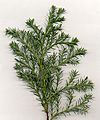|
Chamaecyparis pisifera
Chamaecyparis pisifera (Sawara cypress or Sawara Japanese: サワラ, romanized: Sawara) is a species of false cypress, native to central and southern Japan, on the islands of Honshū and Kyūshū.[2][1] DescriptionIt is a slow-growing coniferous tree growing to 35–50 m tall with a trunk up to 2 m in diameter. The bark is red-brown, vertically fissured and with a stringy texture. The foliage is arranged in flat sprays; adult leaves are scale-like, 1.5–2 mm long, with pointed tips (unlike the blunt tips of the leaves of the related Chamaecyparis obtusa (hinoki cypress), green above, green below with a white stomatal band at the base of each scale-leaf; they are arranged in opposite decussate pairs on the shoots. The juvenile leaves, found on young seedlings, are needle-like, 4–8 mm long, soft and glaucous bluish-green. The cones are globose, 4–8 mm diameter, with 6–10 scales arranged in opposite pairs, maturing in autumn about 7–8 months after pollination.[2] Related speciesA related cypress found on Taiwan, Chamaecyparis formosensis (Formosan cypress), differs in longer ovoid cones 6–10 mm long with 10–16 scales.[2] The extinct Eocene species Chamaecyparis eureka, known from fossils found on Axel Heiberg Island in Canada, is noted to be very similar to C. pisifera.[3] NameThe Latin specific epithet pisifera, "pea-bearing", refers to the small round green cones.[4] UsesTimberIt is grown for its timber in Japan, where it is used as a material for building palaces, temples, shrines and baths, and making coffins, though less valued than the timber of C. obtusa. The wood is lemon-scented and light-colored with a rich, straight grain, and is rot resistant.[5] OrnamentalIt is also a popular ornamental tree in parks and gardens, both in Japan and elsewhere in temperate climates including western and central Europe and parts of North America. A large number of cultivars have been selected for garden planting, including dwarf forms, forms with yellow or blue-green leaves, and forms retaining the juvenile needle-like foliage; particularly popular juvenile foliage cultivars include 'Plumosa', 'Squarrosa' and 'Boulevard'.[5] In cultivation in the UK the following have gained the Royal Horticultural Society's Award of Garden Merit[6] (confirmed 2017):[7]
References
External linksWikimedia Commons has media related to Chamaecyparis pisifera. |
||||||||||||||||||||||||||||||||||












